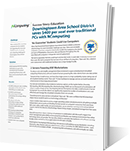SUCCESS STORY
Downingtown Area School District saves $400 per seat over traditional PCs with NComputing
‘No Guarantee’ Students Could Use Computers
When Ray Kase joined Downingtown Area School District (DASD) as director of technology, his most immediate challenge was clear: Slow and unreliable computers meant less computer time for the 12,000 K-12 students in the district just west of Philadelphia. Classrooms, labs and libraries throughout the city were filled with computers in desperate need of replacement.
“We had no guarantee that kids could log in and do their work. It could take 15 minutes to boot and then crash. We had to jumpstart the turnover of our old fleet of computers,” Kase said. Yet, a district-wide replacement with traditional hardware was a major budget hurdle.
2 Servers Powering 850 Workstations
To reduce costs and simplify management, Kase envisioned a super centralized and virtualized computing infrastructure, with one cluster of servers powering the entire district from one data center.
“Instead of lots of small servers, we have three large servers in a high-availability cluster taking care of all virtualized desktop needs,” Kase said. “It’s less hardware to manage and we can build hundreds of virtual servers in those large physical boxes.”
For end user workstations, Kase looked at numerous options on the market before choosing NComputing. With NComputing thin client technology, DASD can run thousands of workstations off of just a couple of large servers. NComputing devices themselves only take a small amount of server horsepower. As a result, the district can significantly expand the number of workstations very cost effectively and manage the virtualized computers from one console.
“Everything we do, every service is virtualized,” Kase said. “We were confident that NComputing’s vSpace Server would fit well in our technology architecture.”
vSpace enables many users to access a single operating system simultaneously by virtualizing multiple independent user accounts and dividing the host server’s or computer’s resources. End users have full-screen video, multi-media, user personalization, secure desktop roaming and broad peripheral support. And for the director of technology, vSpace brings simple, centralized management that saves time.
Using NComputing’s vSpace desktop virtualization in combination with Microsoft’s Hyper-V for server management gives DASD a more powerful and flexible user desktop environment than either technology alone can provide. The two allow DASD to centralize the hardware and software running its data center and deliver those applications to end users virtually.
Downingtown has deployed NComputing L300 devices at all buildings across the district, including classrooms, labs, libraries and even administrative offices. Currently, two IBM 3850x5 servers – each with 40 CPS and a terabyte of RAM – are powering 850 workstations, and will eventually run 3,000.
Completely Virtualized Computing Infrastructure
Kase’s virtualized infrastructure gives him a high degree of control over allocating his computing resources. With Microsoft Hyper-V, Kase configures IBM servers into numerous virtual servers. Within Hyper-V, the district uses NComputing’s vSpace Management Center to further determine the number of NComputing workstations running off each virtual server.
DASD’s virtualized environment builds in more flexibility in extending applications to end users. As needed, Kase can use Hyper-V and vSpace to deploy customized computer environments to individual classrooms or labs. Rather than driving out to the school, from his office he simply provisions the necessary virtual machines with customized desktops that users access – in a matter of minutes.
“We can roll out different applications for end users at the high, middle, and elementary school levels. Each server group has a particular set of applications that go with that grade level,” Kase said.
It also means that, if one server becomes unstable, DASD can create a new virtual machine and copy all applications and files, cutting downtime. If one server reaches the extent of its capacity, Kase can also flexibly move end users from one virtual server to another using the Windows Server 2008 RDS connection broker.
Ultimately, DASD plans to house two servers at the data center and the third at a secondary site as a means of providing redundancy.
Looking ahead, with the next rollout of vSpace Server, DASD will be able to manage groups of NComputing virtual machines on the virtual servers, and more easily roll out software updates remotely from a single console.
Six-Figure Savings
With NComputing, DASD significantly reduced the cost of replacing its aging computers, even compared to a low-end PC.
“We’re saving $400 per seat by using NComputing instead of a traditional PC. That includes replacing the monitors, keyboards and mice,” Kase said.
At $400 per seat, the district saves $340,000 just on initial costs. As Kase works toward the eventual goal of 3,000 workstations, the savings will top $1 million. That doesn’t even take into consideration the massive energy savings of running three physical servers instead of 3,000 traditional computers.
Ultimately, NComputing enabled DASD to bring new computing workstations to teachers and students more quickly than it could have otherwise.
“A third grade teacher told us how this has changed computing in her classroom. Before, she sent kids to computers but couldn’t guarantee that they could log in and do their work. Now, they work every time, so more kids get to use computers; and they are productive during that precious classroom time,” Kase said.
Suggested reading




